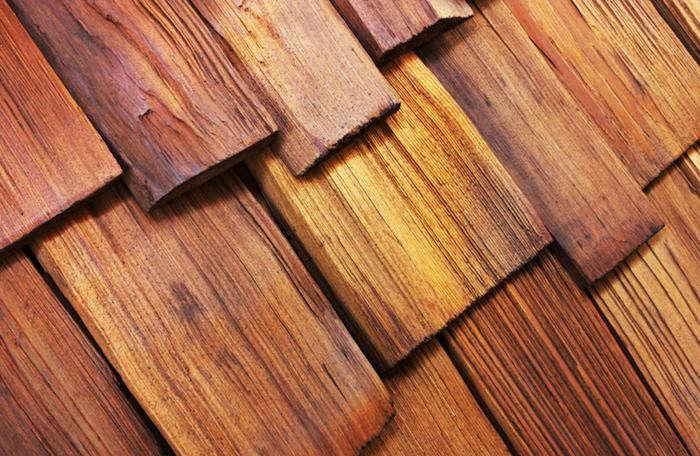There’s no doubt that wood shingle roofs are full of character and natural beauty, but they come with a cost. This expensive investment requires maintenance. Are wood shingle roofs worth it?
Is there a difference between a wood shingle and a wood shake?
Yes, the difference is in how they are made:

Above: Shakes are hand split, not sawed, from a larger piece of wood. They are thicker at the butt (the end that shows when laid on a roof) than they are at the base. Less uniform than shingles, shakes are favored for their rustic appearance and variance in size and shape; they’re generally highly textured. Variations include shakes with sawed backs, and tapered shakes with sawed sides. Photograph via Capstone Brothers Roof Contracting.

Above: Shingles, on the other hand, are machine sawed. They are more uniform in thickness than shakes and have an even taper.
(Note: For the remainder of this post, we use the term “shingle” to refer to both wood shakes and shingles.)
What type of wood is used?
Wood shingles are typically made from cedar (Western red, yellow, or white), which is known to be durable, flexible, long-lasting, moisture-resistant, and insect-repellent. Cedars contain oils that naturally prevent decay. The grain of red cedar is particularly good for accepting stains and fire retardants. Yellow cedar has a tighter grain, which makes it more water- and insect-repellent, but not as good for staining or painting. White cedar is more like red, but since it’s especially fast-growing, it’s a better choice in terms of sustainability. Cypress, pine, and redwood are also used for shingles.

Above: A roof with medium hand-split cedar shakes. Image via LGC Roofing Contractors.
What are the benefits of a wood shingle roof?
- Aesthetics: Wood shingles offer natural beauty and variations in color and texture. And they get better with age, turning silvery gray as they weather. They sit equally well atop cute cottages as modern wonders.
- Insulation: Wood shingles are great insulators, reducing the cost of heating and cooling. The USDA Forest Service has indicated that real wood roofs and siding have the highest insulation value–better than wood substitutes, asphalt, laminate, or fiberglass.
- Longevity: A properly installed and maintained wood shingle roof should last 30 to 40 years, depending on the grade of wood used and the climate (sun and salt can shorten its life). Proper installation includes a layer of material that allows air to circulate beneath the shingles, allowing them to dry after a rain and extending their life. Many manufacturers offer warranties for 20 to 40 years.
- Extreme Durability: Wood shingle roofs resist wind and impact, so they’re good protectors during storms.
Photograph by Jean-Luc Laloux.
Are wood shingle roofs a boon or bane to the environment?
While wood is a valuable resource, it is a natural one, and with a small amount of effort you can source shingles that are made with trees from certified sustainable forest. Far less energy is expended in the manufacturing of wood shingles than with manmade materials. Also, when and if your roof needs replacing (ideally, not in your lifetime), the biodegradable shingles can be turned into mulch. Combine these attributes with a wood roof’s energy-saving nature, and it can certainly be considered an eco-friendly choice.
What maintenance does a wood shingle roof need?
Now for the news you don’t want to hear: Just like people, wood shingle roofs require ongoing maintenance to keep their health and longevity. Because wood expands and contracts, and is porous, the biggest threat is moss and mold growth. Depending on the wetness of your climate, you’ll need to pressure- or power-wash your roof every three to five years, and apply a cleaner/preservative like Linseed Oil. Removing moss and mildew is good not only for the health of the roof, but also for aesthetic reasons. Debris such as rotting leaves should be cleared away regularly. And your installer/supplier may recommend a sealant to extend the durability of the wood.
What about fire?
There is no doubt that wood is combustible. That said, many wood shingles on the market today have been treated with fire retardant, giving them a rating that meets fire safety standards. Check with your local housing codes for requirements. It’s also a good idea to ask your insurance agency if different rates are charged depending on roofing material. Some people believe that a wood shingle roof is better in the event of fire: If the fire burns through the roof, toxic fumes won’t be trapped in the house.
How much does a wood shingle roof cost?
The cost of materials and installation for a wood shingle roof is higher than some of its manmade lookalikes, and similar to quality metal roofs. Estimates range from $500-$900 a square (roofing lingo for 100 square feet). The price varies depending on the heft (medium vs heavyweight shingles) and quality of the wood (hard-to-find heartwood cedar vs the outer wood of younger cedar), your location, and the size and complexity of the roof.

Above: Out with the old and in with the new wood shingles. Image via Wall-to-Wall Contracting.
Wood Shingle Roof Recap
Pros:
- Naturally beautiful
- Energy-efficient insulator
- Breathable
- Durable; withstands stormy weather
- Long-lasting if properly maintained
Cons:
- Flammable
- Expensive
- Requires regular maintenance
- May not be good for houses in very wet climates
Researching roofs? We’ve done some of the work for you. See our earlier roofing features:
- Hardscaping 101: Standing Seam Metal Roofs
- Hardscaping 101: Clay Roof Tiles
- Hardscaping 101: Green Roofs
- Hardscaping 101: Asphalt Shingles
Working on other parts of your house’s exterior? See all of our Hardscaping 101 Features.









Have a Question or Comment About This Post?
Join the conversation